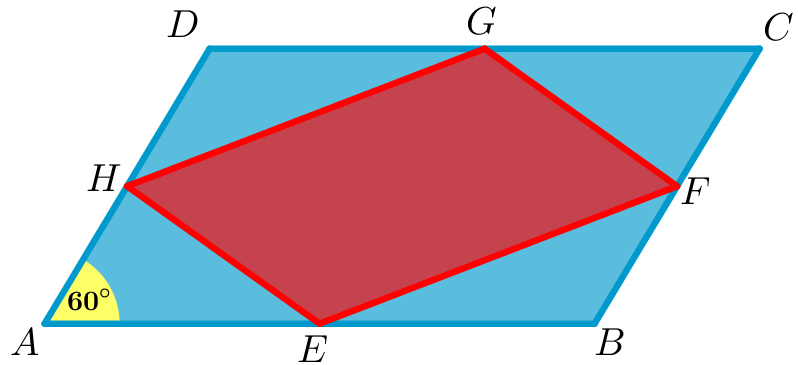Parallelogram inside a parallelogram
The
is a paralleolgram. The midpoints of the
sides are
and
, respectively. The perimeter of the
parallelogram is
, and the perimeter of the
quadrilateral is
. We know that
.

If the minimum value of is , where and are integers, and is square-free, then find the value of .
The answer is 8.
This section requires Javascript.
You are seeing this because something didn't load right. We suggest you, (a) try
refreshing the page, (b) enabling javascript if it is disabled on your browser and,
finally, (c)
loading the
non-javascript version of this page
. We're sorry about the hassle.
Relevant wiki: Arithmetic Mean - Geometric Mean
Let A D = B C = a and A B = C D = b , then K = 2 ( a + b ) . By cosine rule:
E H 2 ⟹ E H = A H 2 + A E 2 − 2 ⋅ A H ⋅ A E cos ∠ D A B = 4 a 2 + 4 b 2 − 2 ⋅ 2 a ⋅ 2 b cos 6 0 ∘ = 2 a 2 + b 2 − a b
Similarly,
H G 2 ⟹ H G = 4 a 2 + 4 b 2 − 2 ⋅ 2 a ⋅ 2 b cos 1 2 0 ∘ = 2 a 2 + b 2 + a b
Therefore, k = a 2 + b 2 − a b + a 2 + b 2 + a b and
K k = 2 ( a + b ) a 2 + b 2 − a b + a 2 + b 2 + a b = 2 1 ( a 2 + 2 a b + b 2 a 2 + 2 a b + b 2 − 3 a b + a 2 + 2 a b + b 2 a 2 + 2 a b + b 2 − a b ) = 2 1 ( 1 − a 2 + 2 a b + b 2 3 a b + 1 − a 2 + 2 a b + b 2 a b ) = 2 1 ( 1 − b a + 2 + a b 3 + 1 − b a + 2 + a b 1 ) ≤ 2 1 ( 1 − 4 3 + 1 − 4 1 ) = 4 1 + 3 By AM-GM inequality b a + a b ≥ 2
⟹ a + b + c = 1 + 3 + 4 = 8